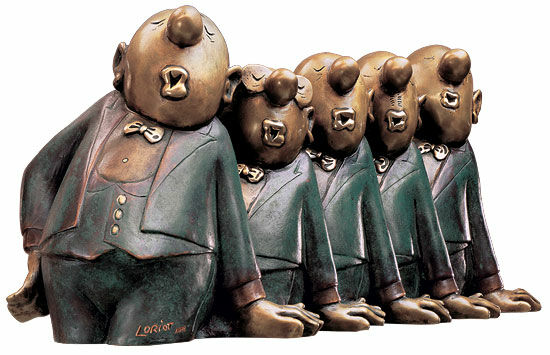Sculpture "Comedian Harmonists" bronze version
Sculpture "Comedian Harmonists" bronze version
Quick info
ars mundi Exclusive Edition | limited, 499 copies | numbered | signed | bronze | handmade | patinated | size 45 x 21 x 13 cm (l/h/d) | weight approx. 10 kg
Detailed description
Sculpture "Comedian Harmonists" bronze version
Teamwork at its best: The Comedian Harmonists are iconic and classical. Their wit and charm, virtuosity and perfection are still unsurpassed today. Loriot depicts the Comedian Harmonists as a symbol of friendship and harmony - human and musical. Their passion for music, sense of humour and the absolute will for perfection weave the bond that holds them together and makes a unity out of loudly different characters.
Loriot has set a monument to the legendary ensemble in his own way. With such accuracy, presence and esprit as only an artist who has mastered the profession of entertainment at the highest level can achieve. Music lovers, art lovers and all those whose concept of success is based on successful cooperation and fine-tuning, the Comedian Harmonists speak from the heart.
Exclusively at ars mundi, Loriot's Comedian Harmonists are available in two editions: made of fine bronze or art cast in Loriot's original colour scheme.
Edition made of fine bronze. Cast using the Lost-Wax-Process, finely patinated. Limited edition 499 copies, numbered and signed. Size 45 x 21 x 13 cm (l x h x d). Weight approx. 10 kg.

About Loriot
1923-2011, a german draughtsman, cartoonist, author, humourist, opera director
He won several german "golden" awards: two Golden Cameras, two Golden Records, the Golden Screen, the Golden Gramophone and the Golden Lion of Honour. Not to mention the Ernst Lubitsch and Adolph Grimme prizes, the Telestar or the Sonderbambi... He was awarded the Order of Merit of the Federal Republic of Germany for his special services.
Loriot is best known for his cartoons and sketches with the characters feature of bulbous noses. For example, two popular characters are Mr Müller-Lüdenscheid and Dr Klöbner, who - unawares - get into the same hotel bathtub and argue so delightful about whether the rubber duck should be allowed in the water or not... In his books, Loriot has dealt intensively with the passage of time. "Loriot's Diary - Zeitgeschehen von Meisterhand" or "Loriot's Heile Welt - Neue gesammelte Texte und Zeichnungen zu brennenden Fragen der Zeit" are just two out of many examples.
Vicco von Bülow, alias Loriot, was without a doubt the "grand seigneur" of German humour. His sketches are often known by heart by a lot of people and no matter the art he was creating - whether as a caricaturist, a humourist, an actor or director - he always achieved something special and memorable.
"Comedy, as I understand it, always deals with self-irony, otherwise something is missing. You have to include yourself." This is the secret to his success and noticeable in all his works. That‘s why his humour is never disparaging, never hurtful. Loriot was always extremely tender even with the characters in his most accurate parodies and precisely observed exposures of middle-class narrow-mindedness. Loriot’s humour, one could say, is not a sharp dagger for grim confrontations, but a fine scalpel that ultimately works towards healing the world with every cut.
The "grand seigneur" of German humour died in August 2011.
An alloy of copper with other metals (especially with tin) used since ancient times.
When casting bronze, the artist usually applies the lost-wax technique which is dating back more than 5000 years. It's the best, but also the most complex method of producing sculptures.
First, the artist forms a model of his sculpture. It is embedded in a liquid silicone rubber mass. Once the material has solidified, the model is cut out. The liquid wax is poured into the negative mould. After cooling down, the wax cast is removed from the mould, provided with sprues and dipped into ceramic mass. The ceramic mass is hardened in a kiln, whereby the wax flows out (lost mould).
Now we finally have the negative form, into which the 1400° C hot molten bronze is poured. After the bronze had cooled down, the ceramic shell is broken off and the sculpture is revealed.
Now the sprues are removed, the surfaces are polished, patinated and numbered by the artist himself or, to his specifications, by a specialist. Thus, each casting becomes an original work.
For lower-quality bronze castings, the sand casting method is often used which, however, does not achieve the results of a more complex lost-wax technique in terms of surface characteristics and quality.
Graphic or sculpture edition that was initiated by ars mundi and is available only at ars mundi or at distribution partners licensed by ars mundi.
Term for an art object (sculpture, installation), which is produced in multiple copies in a limited and numbered edition according to the artist‘s will.
Artist's multiples have been called the most accessible and affordable art on the market.
A plastic work of sculptural art made of wood, stone, ivory, bronze or other metals.
While sculptures from wood, ivory or stone are made directly from the block of material, in bronze casting a working model is prepared at first. Usually, it is made of clay or other easily mouldable materials.
The prime time of sculpture after the Greek and Roman antiquity was the Renaissance. Impressionism gave a new impulse to the sculptural arts. Contemporary artists such as Jorg Immendorf, Andora, and Markus Lupertz also enriched sculptures with outstanding works.









